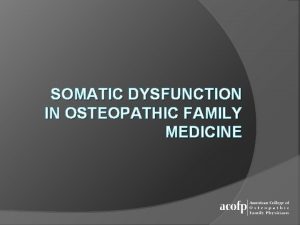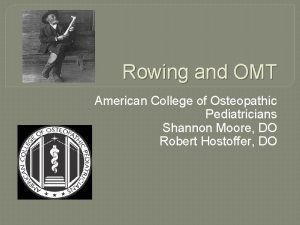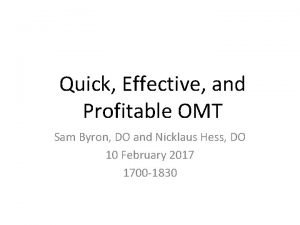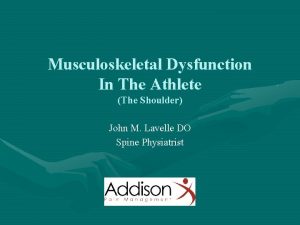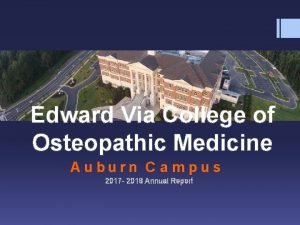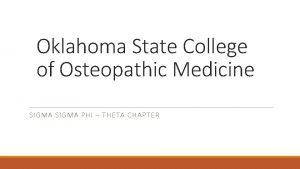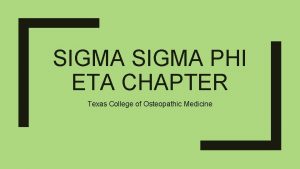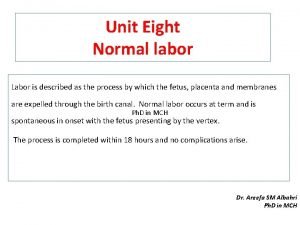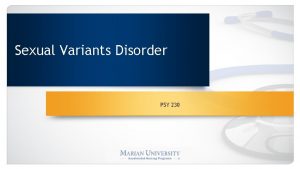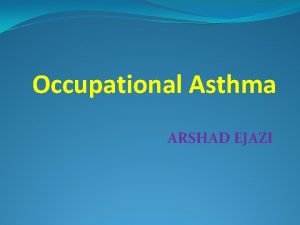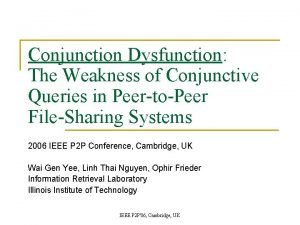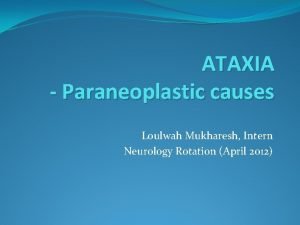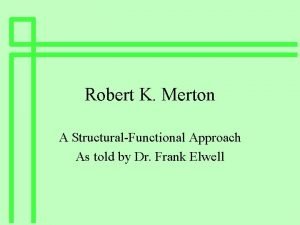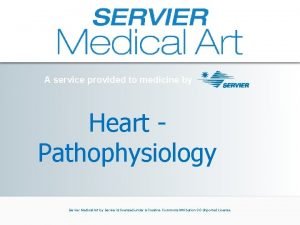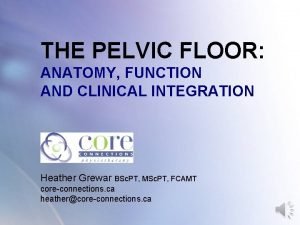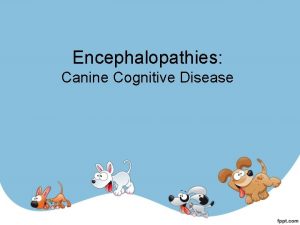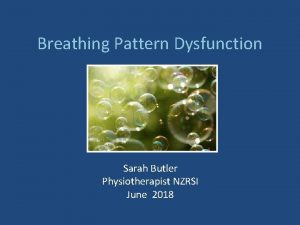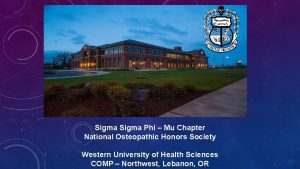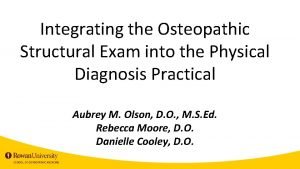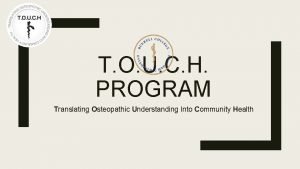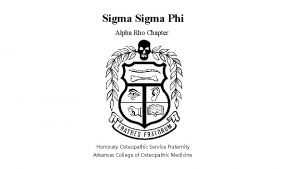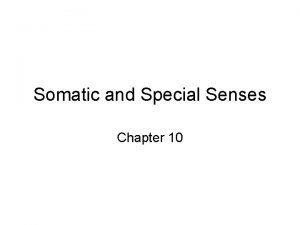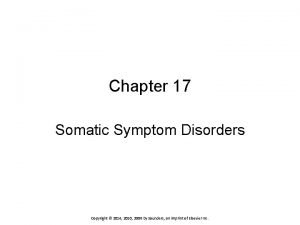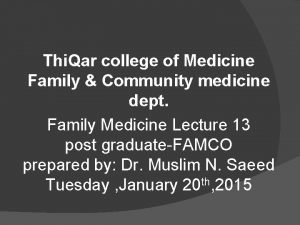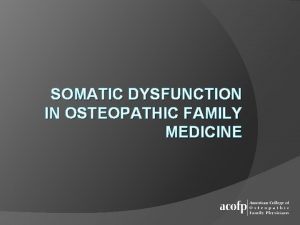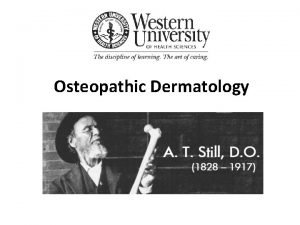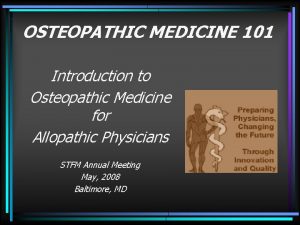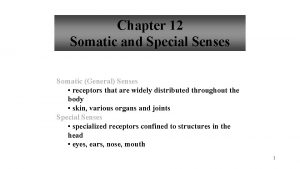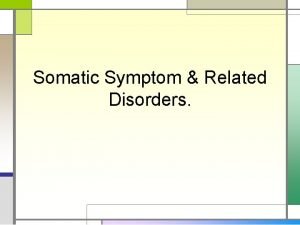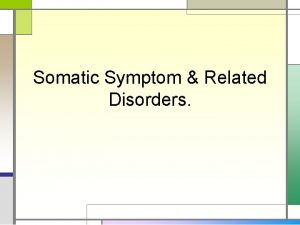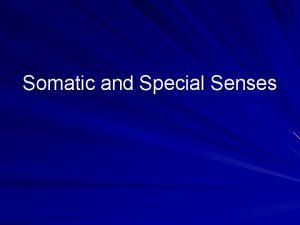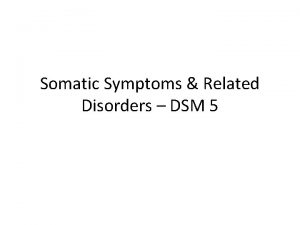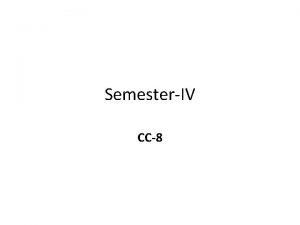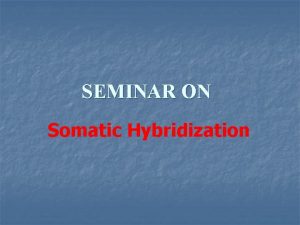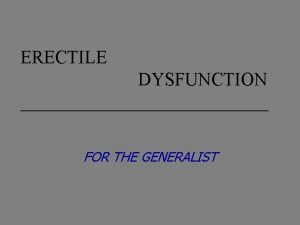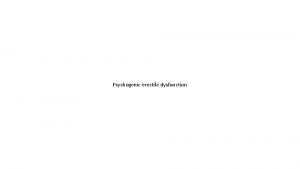SOMATIC DYSFUNCTION IN OSTEOPATHIC FAMILY MEDICINE Chapter 16































- Slides: 31

SOMATIC DYSFUNCTION IN OSTEOPATHIC FAMILY MEDICINE

Chapter 16 THE PATIENT WITH URI

From: Somatic Dysfunction in Osteopathic Family Medicine. Nelson KE, Glonek T, eds. Baltimore, MD: Lippincott, Williams & Wilkins; 2007. This presentation is intended to augment the didactic presentation of Chapter 16, The Patient with an Upper Respiratory Infection, by Kenneth E. Nelson DO, FAAO, FACOFP. Produced by the Department of Osteopathic Manipulative Medicine, CCOM/MWU, Kurt Heinking DO, FAAO (Chair). Developed by: Samuel Yoakum, OMM fellow. Edited by the ACOFP subcommittee for OMM-OPP Publication and Educational Materials, Kenneth E. Nelson DO, FAAO, FACOFP (Chair) © American College of Osteopathic Family Physicians

The Patient with URI Each year, children suffer about five upper respiratory tract infections, (nasal congestion, throat complaints, and cough…) Adults suffer two to three such infections. Osteopathic methods may be used to enhance the standard treatment of upper respiratory conditions. To understand how, you must understand normal anatomy and physiology of the upper respiratory tract.

The Patient with URI The upper respiratory tract (URT) is located between the anterior bones of the calvarium and the bones of the face. The URT lining: ciliated pseudostratified columnar epithelium, nonciliated columnar cells with microvillae, goblet cells, and basal cells.

The Patient with URI Beneath the epithelium lie groups of serous and mucous glands. Secretions from these glands produces a protective coating that: 1. keeps the epithelial surface from desiccating, 2. humidifies inspired air, 3. functions as a first line of defense against infections.

The Patient with URI This protective coating is bilayered. The outer sticky mucous layer entraps particulate matter and contains immuno-globulins and the bactericides lysozyme and lactoferrin. Beneath the outer mucous layer is a fluid serous layer. It allows the cilia of the epithelium to sweep the secretions through the nose in an anterior-posterior direction at a rate of 6 mm/min. Typically 1000 cc of mucous traverse the URT on a daily basis.

The Patient with URI The nasal mucosa contains cavernous vascular tissue with large venous sinuses that, under autonomic control, can shrink or swell to effect the size of the nasal passages. As air traverses the nose the nasal turbinates create turbulence and the air is cleaned, humidified, and warmed.

The Patient with URI The resistance to the passage of air through the nose determines to a great extent the gradient of intrathoracic pressure during the respiratory cycle. This alternating positive/negative intrathoracic pressure draws lymph centrally into the venous circulation, draining the extremities, including the head and neck.

The Patient with URI Increased nasal congestion will initially result in increased turbulence of inspired and expired air and a greater inspiratory/expiratory intrathoracic pressure gradient. This facilitates the cleansing and conditioning of inspired air and lymphatic drainage respectively.

The Patient with URI However. . . as nasal congestion progresses to relative obstruction the patient shifts from nasal to mouth breathing. Mouth breathing is associated with significantly less resistance than nasal breathing. Inspiratory/expiratory intrathoracic pressure gradient is decreased. The cleansing and conditioning effect of nasal respiration is lost.

The Patient with URI This has been shown to result in decreased thoracic cage movement with resultant decreased vital capacity, hypoventilation, and decreased pulmonary circulation with a tendency toward the development of respiratory acidosis.

The Patient with URI The efficient function of the URT as a conduit, humidifier, conditioner, and primary defense against infection can be impaired by somatic dysfunction. This impairment predisposes the region to disease and retards recuperation. Somatic dysfunction does this mechanically and also reflexly through the nervous system.

The Patient with URI OMT is applied to treat somatic dysfunction. To determine how to treat the patient with an upper respiratory problem you must answer the following questions: What effect does somatic dysfunction have upon the upper respiratory tract? 1. mechanical? 2. circulatory? 3. autonomic?

The Patient with URI Somatic dysfunction of the upper thoracic, cervical, and cranial regions can be wholly responsible for functional symptoms and/or pain complaints referable to the upper respiratory tract. Deep facial pain may result from high cervical somatic dysfunction. “Anterior” occiput and “anterior” atlas.

The Patient with URI The mechanical impact of somatic dysfunction upon the URT may be indirect through its affect upon venous and lymphatic drainage from the head and neck. Myofascial dysfunction of the anterior soft tissues of the neck. Decreased thoracic cage compliance due to dysfunction of the thoracic spine, ribs, thoracic inlet and diaphragm.

The Patient with URI Posture effects the upper respiratory tract. Conditions that increase thoracic kyphosis: poor paravertebral muscle tone, Type I group curve mechanics, upper thoracic Type II flexion dysfunction. Result in compensatory increased cervical lordosis. Increase anterior neck soft tissue tension. Increase the tendency for mouth breathing.

The Patient with URI Cranial dysfunction and upper cervical dysfunction also can produce increased cervical lordosis with a shift toward mouth breathing. A shift to mouth breathing decreases the efficiency of respiratory mechanics and increases passive congestion of the URT.

The Patient with URI The efficient function of the upper respiratory tract is predicated upon a dynamic state of balance between sympathetic and parasympathetic control. Disruption of this balance results in functional symptomatology with impaired efficiency of the upper respiratory tract.

The Patient with URI Somatic dysfunction is associated with a state of neurologic hyperirritability that can effect the upper respiratory tract. Somatovisceral reflexes have their effect through the autonomic nervous system resulting in exaggerated sympathetic or parasympathetic reactions.

The Patient with URI The sensory input from the upper respiratory tract reaches the central nervous system through the trigeminal nerve. The trigeminal nerve supplies motor neurons to the muscles of mastication. Consequently one somatic reflection of an upper respiratory viscerosomatic reflex may be palpated in these muscles, particularly the temporalis muscles.

The Patient with URI Parasympathetic innervation of the upper respiratory tract comes from CN VII, the Facial nerve. Pre-ganglionic fibers synapse in the pterygopalatine ganglion. They reach their final destination through the palatine, nasal, and pharyngeal branches of the trigeminal nerve. The constrictor muscles of the pharynx receive motor innervation from the vagus.

The Patient with URI Sympathetic supply comes from the upper five (predominantly upper three) segments of the thoracic spinal cord. The pre-ganglionic fibers synapse in the superior cervical ganglion. The post-ganglionic fibers form the carotid plexus. They follow the vascular supply and traverse the pterygopalatine ganglion to reach the upper respiratory tract with branches of the trigeminal nerve.

The Patient with URI Dysfunction of the cranial base can result in cranial nerve entrapment with functional alteration of the facial and vagus nerves. This can effect the upper respiratory tract through altered parasympathetic and pharyngeal motor activity. KEN

The Patient with URI Tissue texture change and tenderness of the upper cervical paravertebral soft tissues has been described as a viscerosomatic reflex from the upper respiratory tract. The trigeminal nerve is sensory from the upper respiratory tract. Trigeminal afferent activity induces the reflex discharges in the upper cervical nerves that innervate the posterior neck muscles.

The Patient with URI A proposed sequence for the diagnosis of somatic dysfunction and the use of OMT when treating a patient with an upper respiratory infection would be as follows:

With the Patient Seated Diagnose and Treat Thoracic cage (spine, ribs, inlet and diaphragm. 1. To enhance lymphatic drainage of the upper respiratory tract. The region may be further treated with the patient supine (or prone). Upper thoracic spine and ribs. 2. To effect sympathetic reflexes and further enhance lymphatic drainage of the upper respiratory tract.

With Patient Supine Diagnosis and Treat 1. Cervical dysfunction. 2. Utilize suboccipital myofascial release To address trigeminal reflexes. To address vagal reflexes. To address mechanics that predispose to mouth breathing. Trigeminal nerve techniques: 3. Effects sympathetic reflexes with resultant vasoconstriction in the nasal mucosa. Effects parasympathetic reflexes and liquifies nasal secretions.

With Patient Supine Diagnosis and Treat Anterior neck soft tissues 4. To enhance lymphatic drainage of the upper respiratory tract. 5. Thoracic lymphatic pump Also to enhance lymphatic drainage of the upper respiratory tract.

The Patient with URI Thus the diagnosis and treatment of somatic dysfunction may be employed to: Enhance the body’s recuperative abilities And reduce patient discomfort and therefore the need for symptom suppressing medications.

ANY QUESTIONS OR DISCUSSION?
 Urt
Urt Rib somatic dysfunction
Rib somatic dysfunction Zink common compensatory pattern
Zink common compensatory pattern Rib somatic dysfunction
Rib somatic dysfunction Edward via college of osteopathic medicine - auburn campus
Edward via college of osteopathic medicine - auburn campus Dr courtney mapes
Dr courtney mapes Psi sigma alpha osteopathic honor society
Psi sigma alpha osteopathic honor society True labour pain
True labour pain Orgasmic dysfunction
Orgasmic dysfunction Occupational asthma
Occupational asthma True labour pain
True labour pain Conjunction dysfunction meaning
Conjunction dysfunction meaning What causes ataxia
What causes ataxia Cerebellar dysfunction
Cerebellar dysfunction Robert merton structural functionalism
Robert merton structural functionalism Diastolic dysfunction echocardiography
Diastolic dysfunction echocardiography Trunctus
Trunctus Nulliparous
Nulliparous Executive dysfunction
Executive dysfunction Canine cognitive dysfunction
Canine cognitive dysfunction Nzrsi
Nzrsi What is harmful dysfunction
What is harmful dysfunction Psi sigma alpha osteopathic honor society
Psi sigma alpha osteopathic honor society Omm in physical exam
Omm in physical exam Ouhcom touch hours
Ouhcom touch hours Arcom mission statement
Arcom mission statement Chapter 10 somatic and special senses
Chapter 10 somatic and special senses Chapter 29 somatic symptom and dissociative disorders
Chapter 29 somatic symptom and dissociative disorders Chapter 17 somatic symptom disorders
Chapter 17 somatic symptom disorders Types of family in community medicine
Types of family in community medicine Principles of family medicine
Principles of family medicine Halifax family medicine residency
Halifax family medicine residency
